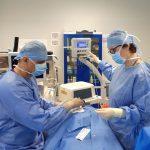2020 European Thyroid Association presented new clinical practice guideline for the use of image-guided ablation in benign thyroid nodules
Thyroid nodules
Thyroid nodules are common in the adult population with a prevalence at ultrasound (US) examination of up to 50% in adult females and 30% in males. Most lesions are cytologically benign and neither cause local symptoms nor warrant treatment. However, a non-negligible number of patients experience pressure symptoms, complain of cosmetic concerns, or develop subclinical or overt hyperthyroidism due to an autonomously functioning thyroid nodule (AFTN). The above leads, in European countries, to thousands of patients undergoing surgical treatment despite evidence of a benign nodule, most of whom have not been offered any non-surgical therapy options.
Thermoablation
Currently, US-guided TA procedures may be considered for selected cases as alternative options to the wellestablished treatments. TA can change the natural history of benign thyroid lesions that keep growing over time in order to prevent or control symptoms without causing hypothyroidism and to reduce risk of surgical complications.
Notably, after nearly 20 years of clinical use, there is no evidence of TA techniques causing thyroid neoplasia.
Classification for surgery
In the frame of a patient-tailored approach, the following factors need consideration when contemplating the use of a TA procedure for thyroid nodules in young and
adult patients:
• Risk of malignancy should be reliably ruled out and the advantages and disadvantages of all available options weighed in a dialogue with the patient.
• TA procedures should not be used for decreasing the volume of asymptomatic thyroid nodules, unless there is documented and clinically significant growth over time.
• In case of cystic (or predominantly cystic) symptomatic nodules, EA is to be preferred as the most effective, rapid, and least expensive treatment. TA may be considered for cystic lesions that relapse after EA or for those with a residual solid nodule following EA.
• TA should aim at the most complete destruction of the targeted nodule in order to alleviate symptoms and prevent regrowth while maintaining safe procedures and minimizing the risk of side effects. In general, spongiform and complex nodules are better candidates for TA compared to solid compact nodules.
New clinical practice guideline for the use of image-guided ablation in benign thyroid nodules
• TA is associated with a low rate of major and minor complications, but adverse effects are potentially severe.
Therefore, the operators need a dedicated training in image-guided thyroid therapeutic procedures.
• TA effects may be stable for years. However, nodule re-growth may occur, and a decision to repeat treatment or offer a different treatment option, for example surgery, needs to be reached together with the patient.
• Among the available TA techniques, LTA and RFA have long been used by several centers, providing robust and consistent clinical results. MWA has only recently been used for treatment of thyroid nodules and needs further validation, as does HIFU.


